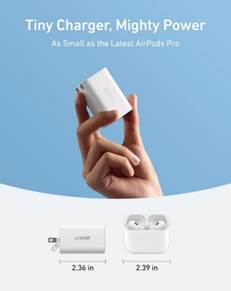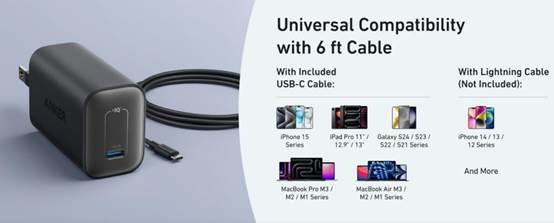Choosing
the appropriate charger is crucial for ensuring the effective and safe charging
of your devices. Making an erroneous judgment is facile when confronted with a
multitude of choices, spanning from premium brands to budget imitations. It is
essential to identify the optimal charger for your smartphone, as they differ
in voltage, wattage, connector type, and technology. The appropriate charger
not only prolongs battery longevity but also safeguards it from damage,
regardless of whether you are charging a tablet, laptop, or smartphone. This
essay will outline the essential aspects to consider in order to select a
charger that optimally fulfills your requirements and functions as expected.

Why Picking the Right Charger Matters
The Impact of Using the Wrong Charger
Using
an incompatible charger can cause poor performance, sluggish charging, or even
harm to your smartphone. Many gadgets demand certain power outputs, and
utilizing insufficient chargers can cause your device to overheat or drain the
battery quicker than it charges. Mismatched charging can impair battery health
and limit its lifespan. In the worst-case scenario, an incompatible charger may
fail to function at all or damage internal components. That's why choosing a
charger that meets your device's specifications is more than just a
convenience; it's an important step in protecting your investment and ensuring
effective performance.
How Charger Specs Affect Charging Speed
Charging
speed is greatly dependent on the charger's wattage and the device's power
consumption. A high-wattage charger, such as the Anker Nano Charger (100W), can
significantly reduce charging time, recharging a 14-inch MacBook Pro to 50% in
27 minutes under optimal conditions. However, using a low-watt charger with a
power-hungry smartphone would result in excruciatingly slow charging. It's
critical to determine whether your device supports rapid charging and then pair
it with a charger that matches or exceeds those requirements. Using the exact
specifications guarantees that you receive the best performance without
jeopardizing safety or battery life.
How to Identify a High-Quality Charger
Look for Safety Certifications and Labels
Reliable
chargers should have certifications like UL, CE, or FCC, demonstrating that
they meet stringent safety and quality criteria. These labels are more than
just for show; they confirm that the charger has been tested for safe operation
under a variety of scenarios. High-end solutions include built-in protections
and explicit labeling to reassure users of their reliability. Avoid products
without these insignia, as they frequently cut costs in design and materials.
When looking for a new charger, consider certified models to assure
compatibility, efficiency, and long-term device protection.
Recognize Trusted Brands vs. Counterfeits
Not
all chargers are made equal, and counterfeits might resemble well-known brands.
When selecting a charger, stick to well-known brands such as Anker. Anker Nano
Charger is renowned for its sturdy construction, dependable charging, and
unique GaN technology. Counterfeit products may cost less initially, but they
frequently fail and pose major safety risks. To avoid fakes, buy straight from
the maker or an authorized merchant. Brand reputation is founded on
consistency, so staying with renowned names guarantees that you get the
performance you expect.
Read Reviews and Expert Comparisons
Before
purchasing a charger, it is advisable to study user evaluations and
professional comparisons. Look for feedback on charging speed, durability, and
real-world performance. Product reviews regularly emphasize the Anker Nano
Charger's compact shape, powerful performance, and travel-friendly structure.
Expert tech sites frequently conduct speed and heat tests, providing unbiased
information about how a charger performs under stress. Real user experiences
might help you identify reoccurring issues or unexpected benefits. This
research helps you avoid low-quality chargers and choose one that provides
consistent, safe, and efficient power to all of your devices.

Which Charger is Best for Multi-Device Charging?
Consider Charging Stations and Multi-Port Hubs
If
you have several devices, a charging station or multi-port hub provides
convenient and clutter-free charging. These solutions allow you to charge
multiple devices at the same time, including phones, tablets, laptops, and
wearables. Look for devices that include both USB-A and USB-C connections to
accommodate a variety of device kinds. Premium choices, such as the Anker Nano
Charger (100W), offer quick charging via numerous connections, making them
suitable for families and professionals. A tiny hub reduces the number of cords
and plugs required, making it ideal for desktops or nightstands. Always check
the total wattage to ensure that all of your devices charge efficiently and
without power drops.
Match Wattage and Power Output for Each Device
Each
gadget has its unique power requirements. Thus, your charger must meet or
surpass those wattages. For example, a MacBook may require 60W-100W, whereas a
phone may require only 18W. Using a charger like the Anker Nano Charger (100W)
provides plenty of juice for high-demand devices while smartly lowering output
for smaller ones. Chargers with dynamic power distribution are great for
multi-device charging since they balance output according to each device's
need. Wattage alignment minimizes overheating, delayed charging, and device
damage, making it an important consideration when charging many devices from a
single source.
Portability and Travel-Friendly Options
Travelers
want chargers that are compact, lightweight, and adaptable. The Anker Nano
Charger (100W) is a stunner, measuring 62% smaller than conventional 96W
chargers and featuring a foldable plug and 6-foot USB-C cord. It has enough
power to charge a laptop while remaining compact enough to fit in your pocket.
Its robust prongs keep it in place throughout the operation, while GaN
technology provides dependable performance without bulk. For people who
frequently change workspaces or travel overseas, portability can be just as
crucial as power. Choosing a travel charger ensures that you're always ready to
power up—without the weight.
Conclusion
Choosing
the best charger requires balancing power, safety, and portability. A poor pick
might slow you down or even harm your equipment, whereas the appropriate one,
such as the Anker Nano Charger (100W), can improve your workflow and protect
your technology. Always check for safety certifications, read user reviews, and
select reputable brands. When charging numerous devices, ensure that the
overall wattage is sufficient for all of them, and favor portable solutions for
a mobile lifestyle. Whether you're shopping for an apple charger or a multi-device
powerhouse, making an informed choice ensures faster, safer, and more efficient
charging every time.
